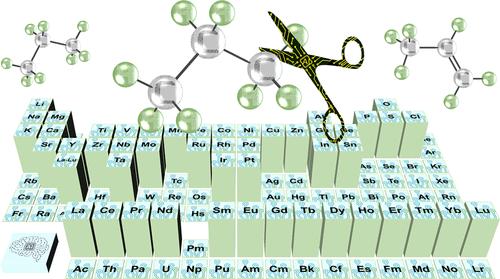基于可解释机器学习和实验验证的氧化铝负载丙烷脱氢催化剂的开发
IF 13.1
1区 化学
Q1 CHEMISTRY, PHYSICAL
引用次数: 0
摘要
丙烷直接脱氢(PDH)反应是丙烯生产的关键途径之一,依赖于高性能催化剂的开发,这通常需要经过耗时的试错策略才能实现。在本研究中,建立了一个机器学习工作流程,包括数据准备和可靠机器学习模型的开发及其评估、解释和应用五个阶段,以探索以丙烯产率为目标的PDH催化剂筛选和设计中的数据驱动研究范式。整理了氧化铝负载催化剂催化PDH反应的文献数据。对12种算法进行了评价,CatBoost模型具有较高的准确率和泛化能力,训练集的决定系数(R2)为0.992,测试集的决定系数(R2)为0.973。利用该模型,我们筛选出了两种极具发展前景的三元催化剂。实验验证表明,这两种催化剂的预测值与丙烯的瞬时产率非常接近。在筛选的催化剂中,PtSnZr/γ-Al2O3表现出较高的丙烯收率,并在13.5 h内保持50%以上的收率,预计在H2S预处理条件下,这些催化剂的瞬时丙烯收率将进一步提高。可解释的机器学习工具(Shapley加性解释和部分依赖图分析)被用来解释模型。本研究通过揭示文献数据中隐藏的构效关系,为机器学习在轻烷烃多相催化转化中的应用提供了有价值的见解,并有助于催化剂的开发。本文章由计算机程序翻译,如有差异,请以英文原文为准。

Alumina-Supported Catalyst Development for Propane Dehydrogenation via Interpretable Machine Learning and Experimental Validation
The direct propane dehydrogenation (PDH) reaction constitutes one of the key routes for the production of propylene and relies on the development of high-performance catalysts, which is generally achieved following a time-consuming trial-and-error strategy. In this study, a workflow of machine learning running five stages, i.e., data preparation and the development of a reliable machine learning model and its evaluation, interpretation, and application, was established to explore the data-driven research paradigm in the screening and design of catalysts for PDH with propylene yield as the target. Data from the literature on the PDH reaction catalyzed by alumina-supported catalysts were compiled. Twelve algorithms were evaluated, and the CatBoost model exhibits a high accuracy and generalization capability, with a coefficient of determination (R2) value of 0.992 for the training set and 0.973 for the test set. By employing this model, we screened two highly promising ternary catalysts. Experimental validation demonstrates that the predicted values for these two catalysts are in close agreement with the measured instantaneous propylene yields. Among the screened catalysts, PtSnZr/γ-Al2O3 exhibits a high propylene yield and maintains over 50% yield for 13.5 h. The instantaneous propylene yields on these catalysts are predicted to be further improved upon H2S pretreatment conditions. Explainable machine learning tools (Shapley additive explanations and partial dependence plot analysis) were employed to interpret the model. This study offers valuable insights into the application of machine learning in the heterogeneously catalyzed conversion of light alkanes and aids in the development of catalysts by uncovering a hidden structure–activity relationship in literature data.
求助全文
通过发布文献求助,成功后即可免费获取论文全文。
去求助
来源期刊

ACS Catalysis
CHEMISTRY, PHYSICAL-
CiteScore
20.80
自引率
6.20%
发文量
1253
审稿时长
1.5 months
期刊介绍:
ACS Catalysis is an esteemed journal that publishes original research in the fields of heterogeneous catalysis, molecular catalysis, and biocatalysis. It offers broad coverage across diverse areas such as life sciences, organometallics and synthesis, photochemistry and electrochemistry, drug discovery and synthesis, materials science, environmental protection, polymer discovery and synthesis, and energy and fuels.
The scope of the journal is to showcase innovative work in various aspects of catalysis. This includes new reactions and novel synthetic approaches utilizing known catalysts, the discovery or modification of new catalysts, elucidation of catalytic mechanisms through cutting-edge investigations, practical enhancements of existing processes, as well as conceptual advances in the field. Contributions to ACS Catalysis can encompass both experimental and theoretical research focused on catalytic molecules, macromolecules, and materials that exhibit catalytic turnover.
 求助内容:
求助内容: 应助结果提醒方式:
应助结果提醒方式:


